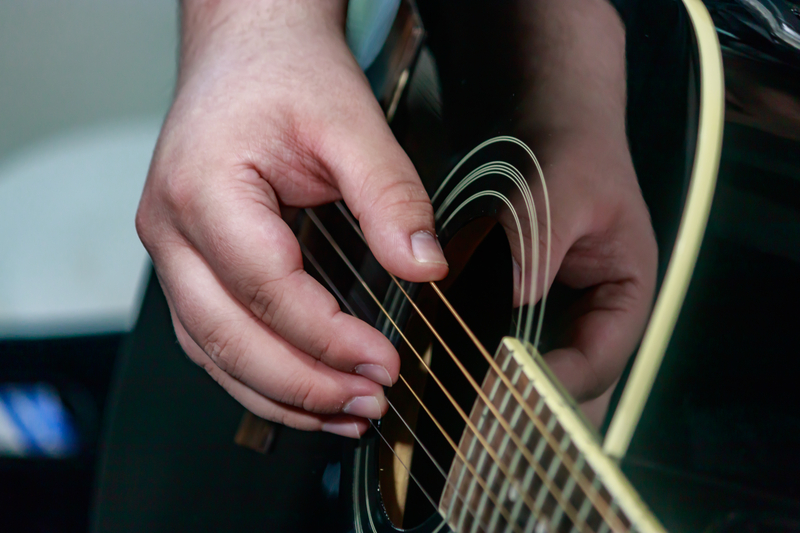5 Essential Fingerpicking Patterns Every Guitarist Should Know

Fingerpicking is a technique that every guitarist should master. In this article, we will explore the basics, including essential techniques and fingerpicking patterns that will take your playing to the next level.
Whether you are a beginner or an experienced player, incorporating fingerpicking into your repertoire can greatly benefit your musical journey. So, let’s dive in and discover the world of fingerpicking!
Fingerpicking Patterns Key Takeaways:
- Fingerpicking is a technique where the strings of the guitar are plucked individually with the fingertips, creating a melodic and complex sound.
- Fingerpicking is an important skill for guitarists as it adds depth and variety to their playing style and allows for more complex and intricate musical arrangements.
- The 5 essential fingerpicking patterns are the Forward Roll, Reverse Roll, Pinch, Carter Scratch, and Boom-Chick, each with its own unique sound and rhythmic pattern.
What Is Fingerpicking?
Fingerpicking, also known as fingerstyle guitar, is a technique used to play the guitar by plucking the strings directly with the fingertips or fingernails.
This technique allows the musician to create intricate melodies and harmonies that may not be easily achievable through traditional strumming. The beauty of fingerpicking lies in the ability to simultaneously play bass lines, chords, and melodies, giving a solo guitarist the ability to sound like a complete band. Fingerpicking stands out from traditional guitar playing as it emphasises individual string plucking over strumming all strings at once. Artists like James Taylor and Paul Simon are renowned for their mastery of fingerpicking, incorporating it into their signature styles and compositions, thereby showcasing its importance in the realm of acoustic music.
Why Is Fingerpicking Important For Guitarists?
Fingerpicking is crucial for guitarists as it allows them to create rich textures, complex chord progressions, and intricate patterns that are challenging to achieve with a plectrum.
By utilising their fingers to pluck individual strings, guitarists can produce a more nuanced and dynamic sound. The tactile precision of fingerpicking grants greater control over tone, volume, and articulation, enabling musicians to express a wider range of emotions through their playing.
Mastering fingerpicking techniques opens doors to exploring diverse musical genres, from the melodic intricacies of jazz to the soulful blues rhythms and the graceful compositions of classical music. Through fingerpicking, guitarists develop a deeper musical understanding and hone their ability to craft intricate arrangements that captivate listeners with their artistry.
What Are The Basic Fingerpicking Techniques?
Mastering basic fingerpicking techniques is essential for guitarists to explore the full potential of their right hand, utilising fingers like the thumb, index, and middle finger to pluck individual strings.
One key fingerpicking technique is alternating bass, commonly used in folk and blues music, where the thumb alternates between two bass notes while the fingers play a melody on the higher strings. This creates a rhythmic and harmonic foundation for the music.
Travis picking is another popular technique named after Merle Travis. It involves a steady alternating bass pattern played by the thumb while the fingers pick out melody and harmony simultaneously. This technique is widely used in country and folk music.
For a more intricate sound, arpeggio picking is used. It involves plucking each note of a chord individually in a sequence, creating a flowing and cascading effect. This technique is common in classical and flamenco guitar playing.
Alternating Bass
Alternating bass is a foundational fingerpicking technique that involves using the thumb to play a steady bass line while the index and middle fingers pick the higher strings simultaneously.
This technique adds depth and rhythm to acoustic guitar playing, creating a full sound reminiscent of a bass player and a guitarist playing together. Players often use this method in folk, blues, country, and even classic rock music to provide a driving rhythmic foundation.
To improve coordination, try starting with simple chord progressions like G-C-D and focus on maintaining a steady bass line while plucking the melody notes. Classic rock songs that showcase the alternating bass technique include ‘Dust in the Wind’ by Kansas and ‘Never Going Back Again’ by Fleetwood Mac.
Travis Picking
Travis picking is a popular fingerstyle technique named after Merle Travis, characterized by a syncopated pattern played by the thumb and index finger simultaneously.
This technique emerged in the early 20th century and revolutionized acoustic guitar playing by blending bass notes with melody lines, creating a rich and rhythmic sound. Its roots can be traced back to traditional folk and blues music, but it has found its way into various genres including country, bluegrass, and rock.
Travis picking has influenced a wide range of guitarists such as Chet Atkins, Tommy Emmanuel, and Mark Knopfler, each adding their own twist to the technique. Its popularity endures due to its versatility and captivating sound that can stand out in both solo and band settings.
To master Travis picking, developing a strong thumb-index coordination is vital. Practice exercises focusing on alternating basslines and intricate fingerpicking patterns can help hone this skill. Experiment with classic Travis picking songs like “Nine Pound Hammer” by Merle Travis or “Blackbird” by The Beatles to apply these techniques in a musical context.
Arpeggio Picking
Arpeggio picking involves playing the notes of a chord individually in a specific sequence, creating a flowing and melodious sound that is common in classical and fingerstyle guitar music.
When mastering arpeggio picking, it’s essential to understand its significance in adding texture and dynamics to chord progressions. By breaking down chords into their individual notes and playing them consecutively, players can enhance the musical depth of their compositions. Arpeggios help in highlighting specific tones within a chord, allowing for a more nuanced and expressive performance.
Popularised by legendary guitarists, arpeggio patterns can be visualised on the fretboard through diagrams that illustrate various shapes and finger placements. These patterns serve as valuable tools for aspiring musicians looking to expand their repertoire of techniques. Investing time in practising arpeggios can significantly improve finger dexterity and fluidity in transitioning between chords.
Clawhammer Picking
Clawhammer picking, often associated with folk and country music, involves a downward plucking motion with the fingernail or thumb and a strumming motion with the back of the nail or the index or middle finger.
This distinctive style of playing has roots in traditional Appalachian music and has been preserved and passed down through generations. With its origins dating back to the African Banjo, clawhammer picking has a rich history intertwined with the culture and storytelling of old-time music.
Artists such as Doc Watson, Tommy Jarrell, and Rhiannon Giddens are renowned for their mastery of the clawhammer technique, demonstrating the versatility and emotional depth it can bring to a performance.
To develop proficiency in clawhammer picking, players can start with simple exercises focusing on the finger movements required for the unique plucking and strumming actions. These exercises help build muscle memory and coordination necessary for fluid and expressive playing.
Classical Picking
Classical picking, prevalent in classical and flamenco guitar, involves intricate finger combinations using the thumb, index, middle, and ring fingers to pluck strings with precision and control.
When diving into classical guitar music, one discovers the rich tapestry of fingerstyle techniques that bring timeless melodies to life. An essential aspect of mastering classical picking lies in developing finger independence and dexterity. To enhance these skills, aspiring guitarists can practise specific exercises that target each finger’s movement and strength.
- Strengthening the individual fingers through exercises like trills, arpeggios, and scales is key to achieving the nimbleness required for intricate classical pieces.
By focusing on finger independence and accuracy, players can navigate complex compositions with finesse and clarity.
What Are The Essential Fingerpicking Patterns?
Fingerpicking patterns play a vital role in creating rhythmic interest and texture in music, with common patterns like the forward roll and reverse roll providing a foundation for intricate fingerstyle arrangements.
These patterns are prevalent in various genres such as folk, blues, and country, each contributing to the unique sound of the music. Understanding how to apply these patterns to different chord progressions can open up a world of possibilities for guitarists looking to expand their repertoire.
Practicing exercises specifically designed to improve fluency in fingerpicking patterns is essential for mastery. Working on these patterns regularly not only enhances dexterity but also improves overall fingerpicking technique and precision.
The Forward Roll
The forward roll is a classic fingerpicking pattern where the thumb plays the bass note, followed by the index finger, and then the middle finger in a continuous motion, creating a smooth and flowing rhythm.
This pattern is prevalent in various musical genres, including folk, blues, and bluegrass. In folk music, artists like Bob Dylan and Simon & Garfunkel often utilise the forward roll to add a melodic undertone to their songs. In bluegrass, players like Tony Rice and Doc Watson showcase the pattern’s speed and agility. To improve thumb and finger coordination, try exercises such as alternating between plucking single notes and arpeggiating chords. Iconic fingerstyle songs like Blackbird by The Beatles and Dust in the Wind by Kansas are great examples to study for mastering the forward roll.
The Reverse Roll
The reverse roll is a fingerpicking pattern where the thumb plays the bass note, followed by the middle finger, and then the index finger, creating a distinctive rhythmic texture that adds complexity to guitar arrangements.
One of the rhythmic variations of the reverse roll involves playing the thumb, ring finger, and then middle finger, which can bring a different feel to the pattern.
This pattern is commonly used in fingerstyle compositions to create dynamic contrasts by alternating between the standard and reversed rolls, adding depth and interest to the music.
To enhance finger independence and speed, a useful exercise is to practise playing scales using the reverse roll pattern, focusing on smooth transitions between the fingers for a fluid and controlled sound.
The Pinch
The pinch is a fingerpicking pattern where the thumb and index or middle finger pluck two strings simultaneously, creating a harmonious blend of notes that enriches the harmonic content of the music.
This technique is widely used in various musical genres to add depth and complexity to chord progressions and melodies. Artists like James Taylor in his song ‘Fire and Rain’ or Ed Sheeran in ‘Photograph’ showcase the versatility of pinch patterns in creating beautiful textures.
To improve your dexterity and precision in executing pinch patterns, try exercises that focus on alternating between different pairs of strings and varying the tempo. Consistent practice will help develop muscle memory and enhance your overall fingerpicking skills.
The Carter Scratch
The Carter Scratch, popularised by Maybelle Carter of the Carter Family, involves a thumb-index-middle finger pattern used in country and folk music to create a rhythmic groove and melodic accompaniment.
Originally developed by Maybelle Carter in the early 20th century, the Carter Scratch revolutionised the way guitarists approached rhythm in country music. Its impact can be felt in countless classic country and folk songs, including iconic tracks like ‘Wildwood Flower’ and ‘Keep On the Sunny Side.’ By mastering this technique, musicians can add depth and soul to their playing, embodying the essence of traditional American roots music.
The Boom-Chick
The Boom-Chick pattern, commonly used in country and bluegrass music, involves a bass note (Boom) played by the thumb followed by a chord strum (Chick) played by the fingers, creating a dynamic and driving rhythm.
The rhythmic versatility of the Boom-Chick pattern is a key element in creating momentum and energy in music. This distinctive pattern not only provides a strong foundation but also adds a sense of forward motion to the musical piece. Artists like Doc Watson and Chet Atkins are renowned for their adept incorporation of the Boom-Chick style in their guitar playing, showcasing its effectiveness in various musical contexts.
To enhance thumb-chord coordination and master the Boom-Chick pattern, aspiring musicians can engage in exercises such as practicing alternating between bass notes and chords slowly at first, gradually increasing speed while maintaining accuracy. Another effective exercise is to isolate the thumb and finger movements, focusing on precision and timing, before integrating them seamlessly.
How To Practice Fingerpicking?
Effective practice is crucial for mastering fingerpicking techniques, as it helps in identifying mistakes, refining movements, and gradually improving speed and accuracy.
Begin your fingerpicking practise sessions with gentle warm-up exercises to loosen up your fingers and wrists. This can include simple finger stretches, light tapping on the strings, and slow scales to get your hands ready for more intricate movements.
When working on specific techniques, focus on targeted drills to address common mistakes, such as inconsistent fingerpicking patterns or timing issues. Building finger strength is essential, so incorporate exercises that challenge each finger individually and collectively.
Practise consistently, even if it’s just for a few minutes each day, to develop muscle memory and ensure steady progress.
What Are The Benefits Of Fingerpicking?
Fingerpicking offers a unique way to express musical creativity, fostering a deep appreciation for the nuances of guitar playing and elevating the skill level of musicians who embrace this technique.
The emotional connection that musicians develop with fingerpicking runs deep, stemming from the intimate bond formed between fingers and strings. Mastering intricate patterns through dedicated practice brings a sense of accomplishment that resonates through every note played. It’s in those moments of getting lost in the music, fingers dancing effortlessly across the fretboard, that the true joy of fingerpicking is revealed. As one explores new musical horizons, the guitar becomes a canvas for endless possibilities and self-expression.
How To Incorporate Fingerpicking In Your Playing Style?
Incorporating fingerpicking into your playing style requires experimentation with different patterns, chord combinations, and stylistic elements to find a unique voice that reflects your musical preferences and skill level.
Try blending traditional strumming techniques with fingerpicking for a more dynamic sound. Explore hybrid picking, where you use a plectrum and your fingers simultaneously, to add complexity to your playing. Additionally, incorporating fingerpicking into your repertoire can enhance the texture and depth of your music, creating a richer sonic experience for both you and your audience. To further develop your fingerpicking skills, consider online lessons or resources that offer guidance on different fingerpicking styles, exercises, and practice routines.
Looking to finesse your technique? Interested in a popular style – like the blues? Or eager to flex your electric guitar skills? You’ll learn it all on our expert-led Elevate courses for guitar.
From the blog

Rockstars in Training: The Best Kids’ Electric Guitars for 2024

Redefining Your Riffs: How Electric Guitar Strings Shape Your Sound


